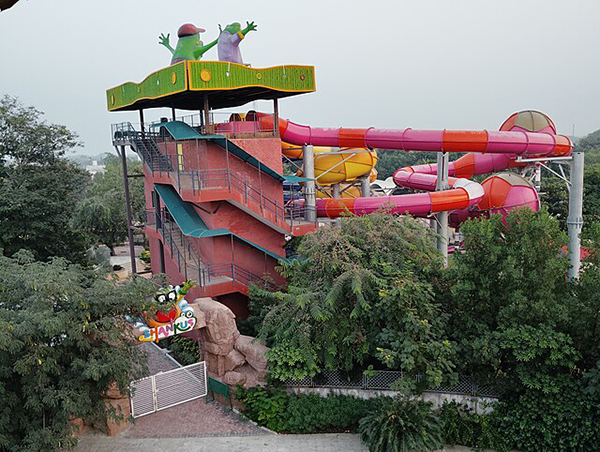Families and thrill-seekers alike frequent water parks because they provide a fun and cool respite from the summer heat.
In addition to places for swimming, floating, bathing, and other barefoot activities, they have water play facilities such swimming pools, water slides, splash pads, water playgrounds, and lazy rivers. A wave pool or flowrider are examples of artificial surfing or bodyboarding environments that are sometimes found at contemporary water parks.
The origins of these parks may be found in the 1940s and 1950s, when public swimming pools began to add slides and other attractions in an effort to draw more people. Attractions like George Millay’s Wet n’ Wild in Orlando, which opened in the 1970s and had a range of water-based attractions, are frequently referred to as the first real water parks.
More people were thrilled by the swift evolution of water slides, which became taller and quicker. Lazy rivers for relaxation, wave pools and bumpy rides for thrill-seekers, and zero-depth entry and splash pools for families are some of the new attractions provided by water parks. A new era in water park experiences began in 1994 when the Great Wolf Lodge, a component of the Polynesian Hotel in Wisconsin Dells, inaugurated the first indoor water park.
Even though these water park activities are thrilling and entertaining, there are certain risks involved. It doesn’t take an expert to see that, as a risk management and safety professional, you’re essentially creating a recipe for disaster whenever you combine elements like water, gravity, velocity, crowds, adrenaline addicts, and sugar-fueled children into one enormous splash zone.
Overseeing safety at a water park is like to running a live reality show with a cast of ten-year-olds, barefooted, and slick, and a set composed completely of concrete and water. One minute you’re climbing the stairs to a slide, and the next you’re in the air, upside down, and praying your swimsuit stays on. Water parks are the epitome of a slippery slope.
Minor bumps and bruises to more catastrophic mishaps requiring medical treatment and, in certain rare cases, death are all possible injuries at water parks.
Like other recreational facilities, water parks experience their fair share of mishaps and injuries. About 4,200 ER visits in the US occurred in 2019 as a result of accidents received at water parks, according to the Consumer Product Safety Commission (CPSC). Water slides, wave pools, lazy rivers, and other park attractions are among the places where these injuries might happen.
According to a National Electronic Injury Surveillance System (NEISS) study, the following injury types are most prevalent at water parks:
Lacerations and Abrasions: Contact with sharp edges or rough surfaces frequently results in cuts and scrapes.
The most common causes of sprains and strains include trips, falls, and slides on damp surfaces.
Fractures: Collisions with other visitors or falls can cause broken bones.
Head Injuries: Collisions or falls, especially on water slides and in wave pools, can result in concussions and other head injuries.
The survey also showed that, with almost 60% of all water park accidents occurring in children and teenagers, these groups are the most impacted. These injuries also have a high financial cost, with millions of dollars being spent each year on medical bills and missed productivity.
The management of water parks should provide all of its employees with thorough safety training that emphasizes first aid, emergency response, and visitor safety. They ought to concentrate on ensuring that non-slip coatings are applied to every walkway. Ride directions and depth markers on warning signs must be clearly visible and, when applicable, bilingual. Reminding people politely and clearly of the rules—like not running or diving—helps them remember to behave safely.
Each attraction’s staff should confirm any weight or height restrictions and make sure visitors know how to ride safely. Parents should be encouraged to keep a close eye on their kids, especially in play areas and wave pools.
To regulate access and enhance visibility, barrier systems including gates, fences, and lifeguard stations should be positioned carefully. To assist avoid mechanical failures and guarantee water purity, management staff should perform daily routine inspections on slides, pumps, drains, and chemical levels.
Particular attention should be paid to high-risk locations where certain attractions call for extra care, such as:
Wave pools may quickly wear out inexperienced swimmers by simulating ocean conditions. For the safety of patrons, the lifeguard density should be as high as possible.
Lazy rivers may seem peaceful, but they can cause crashes or entrapment.
High-speed rides known as speed slides necessitate rigorous adherence to proper posture and rider preparedness. To guarantee safety compliance, attendants should be positioned strategically.
To avoid crowded and rough play, children’s play places need to be age-appropriate and well supervised.
Today’s water parks are updating its security measures and using technology more and more to improve security. For example:
Surveillance systems: Cameras are used to keep an eye on visitor behavior and spot possible risks.
Wearable technology: RFID bracelets can notify employees of crises and track the whereabouts of visitors.
Systems for detecting drowning: AI-enabled underwater cameras are able to identify distress signals and instantly notify lifeguards.
Digital signage: Changing screens can inform visitors of safety messages, weather warnings, and wait times.
In addition to providing their employees with the crucial lifeguard certification training in CPR, first aid, and water rescue, they must also ensure that the training is continuous and conduct emergency exercises to maintain their proficiency and speed up reaction times.
With overlapping zones of duty, lifeguard stations must be positioned to remove blind spots. Regular rotation keeps one alert and helps avoid tiredness.
To raise awareness and reduce the number of heat-related illnesses among visitors, water parks should prioritize educating their consumers about water safety, emphasizing the value of staying hydrated and adhering to safety regulations.
Education, knowledge, and adherence to established safety regulations are necessary to prevent injuries at water parks. Adults must keep an eye on minors, and riders must adhere to the weight and height restrictions. Wearing the right swimwear might help keep injuries at bay. Steer clear of accessories or loose apparel that could get stuck on slides or other attractions. Customers should think about donning water shoes, which can shield feet from sharp items and offer more traction on damp terrain.
Because damp surfaces can be slick and increase the chance of falls, patrons should be aware of them. You should take your time walking and refrain from running in areas with water when you are at a water park. Adult supervision is usually required for children, particularly in regions with deep water or fast-moving attractions. They should also be aware of safety regulations and know how important it is to abide by them.
Due to a number of factors, including age, size, health, etc., not all attractions are appropriate for everyone. Therefore, stay away from rides and attractions that could endanger your health if you have a medical condition or are not a good swimmer.
Up until someone disregards the regulations or lacks common sense, water parks are a blast. Stay safe by paying attention to the kids, wearing appropriate swimwear, staying hydrated, and according to the rules. Keep in mind that everyone has a responsibility to ensure safety. Being proactive in preventing injuries can have a big impact, whether you’re a park employee or a guest.
Friends, stay safe.






